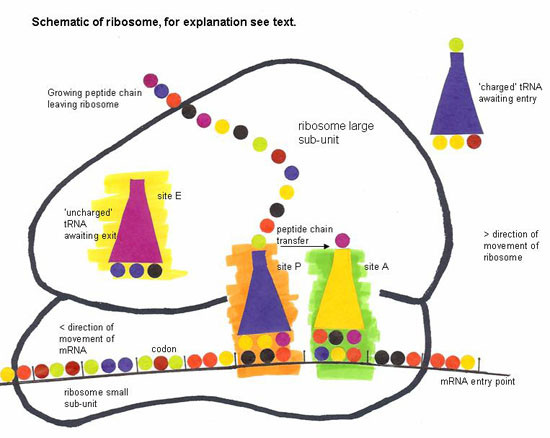Ribosomes are fundamental cellular components often referred to as the protein factories of the cell. These intricate molecular machines are responsible for translating genetic code into functional proteins, a process essential for all life forms. Understanding where ribosomes are located within a cell is key to grasping their diverse roles and the overall process of protein synthesis.
Ribosomes are not confined to a single location within the cell; their distribution is strategically determined by the cell’s needs and the type of proteins being synthesized. Primarily, ribosomes are found in two main locations within eukaryotic cells: freely floating in the cytoplasm and bound to the endoplasmic reticulum (ER), forming the rough ER. Furthermore, ribosomes are also present within mitochondria and chloroplasts, and crucially, they are the protein synthesis machinery in prokaryotic cells as well.
Cytoplasm: Free Ribosomes and Their Role
A significant population of ribosomes exists freely in the cytoplasm, the gel-like substance filling the cell. These “free” ribosomes are not attached to any cellular membranes. Their primary function is to synthesize proteins that are destined to function within the cytoplasm itself. These cytoplasmic proteins include enzymes involved in metabolic pathways, structural proteins of the cytoskeleton, and various other proteins required for cellular processes occurring directly in the cytoplasm.
 Cytoplasmic ribosomes synthesizing proteins
Cytoplasmic ribosomes synthesizing proteins
Alt text: Illustration depicting ribosomes free in the cytoplasm, engaged in the process of protein synthesis.
Endoplasmic Reticulum: Rough ER – Protein Processing Hub
Another major location for ribosomes is the endoplasmic reticulum (ER), a vast network of membranes that extends throughout the cytoplasm of eukaryotic cells. Ribosomes that are destined to synthesize proteins for secretion, insertion into cell membranes, or for organelles like lysosomes, become associated with the ER membrane. This association gives the ER a “rough” appearance under a microscope, hence the name rough endoplasmic reticulum (rough ER).
The rough ER serves as a dedicated compartment for the synthesis and initial modification of these specific protein types. As ribosomes synthesize the polypeptide chain, it is threaded through a channel in the ER membrane and into the ER lumen, the space between ER membranes. Within the ER lumen, proteins undergo folding, modification, and quality control processes. The rough ER, therefore, is not just a location for ribosomes but also a crucial processing and trafficking center for newly synthesized proteins.
Mitochondria and Chloroplasts: Ribosomes in Organelles
Interestingly, mitochondria and chloroplasts, the organelles responsible for energy production and photosynthesis respectively, also contain their own ribosomes. These organelles were once free-living prokaryotic organisms that were engulfed by a host cell in a process called endosymbiosis. As a result, they retained their own genetic material and protein synthesis machinery, including ribosomes.
Mitochondrial and chloroplast ribosomes are structurally more similar to prokaryotic ribosomes than to eukaryotic cytoplasmic ribosomes. This provides further evidence for the endosymbiotic theory. Ribosomes within these organelles synthesize some of the proteins required for their function, contributing to the semi-autonomous nature of mitochondria and chloroplasts within the eukaryotic cell.
Prokaryotic vs. Eukaryotic Ribosomes: Location Differences
In prokaryotic cells, which lack membrane-bound organelles like the endoplasmic reticulum and mitochondria, ribosomes are primarily located in the cytoplasm. Since prokaryotes do not have a nucleus, the processes of transcription (DNA to mRNA) and translation (mRNA to protein) are coupled and occur in the cytoplasm. Ribosomes in prokaryotes, while performing the same core function of protein synthesis, are structurally slightly different from eukaryotic ribosomes, a difference that is exploited by certain antibiotics to selectively target bacterial protein synthesis without harming human cells.
Ribosome Structure and Function: A Brief Overview
Regardless of their location, all ribosomes share a fundamental structure, composed of two subunits: a large subunit and a small subunit. Each subunit is made up of ribosomal RNA (rRNA) and ribosomal proteins. The small subunit is responsible for reading the messenger RNA (mRNA), the genetic blueprint for protein synthesis, while the large subunit catalyzes the formation of peptide bonds between amino acids, the building blocks of proteins.
The process of protein synthesis on ribosomes involves three main stages: initiation, elongation, and termination. In initiation, the ribosome assembles around the mRNA and the first transfer RNA (tRNA) carrying an amino acid. Elongation is the cyclical process where the ribosome moves along the mRNA, adding amino acids to the growing polypeptide chain based on the mRNA sequence. Termination occurs when the ribosome encounters a stop codon on the mRNA, signaling the end of the protein sequence, and the newly synthesized polypeptide is released.
The Importance of Ribosome Location: Impact on Protein Fate
The location of ribosomes directly dictates the fate of the proteins they synthesize. Free cytoplasmic ribosomes produce proteins that will function within the cytoplasm. Ribosomes associated with the rough ER produce proteins destined for secretion, membranes, or specific organelles. Ribosomes within mitochondria and chloroplasts contribute to the protein requirements of these organelles. This spatial organization ensures that proteins are synthesized at the correct location to carry out their specific cellular functions efficiently.
Conclusion: Ribosomes – Ubiquitous and Essential
In summary, ribosomes are not confined to a single location but are strategically distributed throughout the cell to fulfill their essential role in protein synthesis. From the cytoplasm to the rough ER, and even within mitochondria and chloroplasts, ribosomes are ubiquitous and vital components of all cells. Understanding “Where Is The Ribosome Located” provides critical insight into the intricate organization of cellular processes and the remarkable efficiency of protein production, a process fundamental to life itself.
